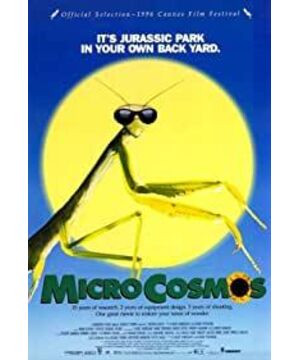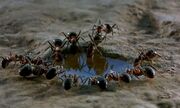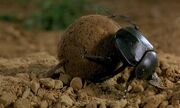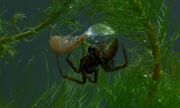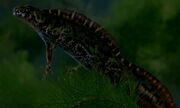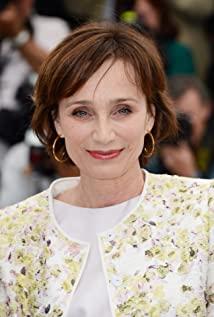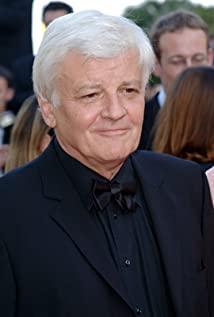ps: In order to complete the film review assignment for the film and television editing professional course, I wrote a lot of non-professional terms below, mainly to let the teacher see that I was really watching this documentary, although it caused me a strong discomfort after watching it. .
First of all, in the overall shooting, I was shocked by many shooting angles. For example, at 28 minutes and 03 seconds, the camera was carried by the ants and then directly transferred to the ants' cave! Then the camera was placed directly in the cave to shoot the ants’ transportation process. When I saw this scene, my head was full of curiosity, and I didn’t know how to achieve such a shooting. There is also an equally unique shooting angle at 35 minutes and 41 seconds. When the woodpecker eats the ants on the ground, first there is a woodpecker's perspective shot, and then there is a shot of looking up at the ants and woodpeckers on the ground from the ground. , such a shooting angle makes me feel amazing and incredible. There is also a shot that simulates the flight of a bee between 9 minutes 55 seconds and 10 minutes 20 seconds, and there is also a shot that simulates the perspective of a dragonfly at 37 minutes and 10 seconds. This kind of documentary will make the film very vivid and interesting.
Then let's talk about the format of this documentary. In my impression, the standard standard of documentaries is commentary. In the documentaries I have watched about humanities, there is almost no commentary, and most of them are natural documentaries. All with commentary, such as "Blue Planet" which I like very much. However, there is almost no commentary in this documentary, except for the opening credits. But I also like a line in the opening commentary: "An hour is like a day, a day is like a season, a season is like a lifetime. To explore the world. We must first remain silent. Listen and watch this Miracle."
Why does this documentary lack descriptive words but still give me a visual shock? This is inseparable from the music and sound in this documentary. According to my rough statistics, there are about ten places where BGM sounded in this documentary, and the tune of each BGM sound is more cheerful or slightly scary. Then when the lens gives close-ups of all animals, there are almost always animal sound effects, and I am very impressed by several of them. The first impressive place is between 8 minutes 30 seconds and 20 minutes 47 seconds to 21 minutes 55 seconds, the bugs and bees here have a very dense vibration of their wings, like a motor, it can't stop at all, give me The ear immediately brought a very exciting feeling. The editing here also basically freezes the shot to the animal flapping its wings. Also, once the camera is moved to the flowers, the sound effects in the documentary become very strange. For example, when the flowers bloom at 9 minutes and 13 seconds, and after the dense sound of flies at 22 minutes and 30 seconds, the camera moves to the flowers withering, and the sound effects are very impressive. It sounds creepy. Of course, this is also what we often say about finding the editing point. General editing will also find the best editing point with the changes of the music, just like the card points we usually see in Douyin. There is also a place where the sound of an animal is very memorable to me at 69 minutes and 34 seconds. There is a very long shot here, it is a mosquito, but at first I watched it for a long time and didn't know it was a mosquito, just looking at its shape and volume It was very similar to a dragonfly, but at the end it buzzed and flew away, which made me instantly understand that this little thing was the mosquito I hated the most.
After talking about the sound effects and sound, I want to talk about the empty shots. I don’t know if the big vision is considered an empty shot in the microscopic world. Again, according to my rough statistics, there are about 23 places in the documentary that cut from the close-up to the big vision and then back to the close-up. There are several things that impress me. The first is the beginning and the end. The beginning made me feel like a dandelion seed perspective, which is quite similar to the beginning of "Forrest Gump". Then walk through the clouds with the camera, and after clearing the clouds and mists, there is a primitive grassland full of business. No matter how fast, no matter how fast, you will come to the microscopic world on the ground. Such a lens assembly is very comfortable and wonderful. The reason lies in the order of editing, because the order of assembling a group of pictures is basically in a progressive relationship of far, full, middle, near, and special. This editing gives the impression that the picture does not jump, it is very stable. (progressive sentence pattern in montage sentence) including like the ending is also full of flavor, but it's in a different order, from close-ups of animals to medium shots of water, then to panorama of the rising sun, and finally to the sky big vision. (The receding sentence pattern in the montage sentence) The meaning of the cut like this at the beginning and the end is that the beginning, from the long shot to the close-up, is to get the audience into the picture and build an emotion with the insects inside. And at the end, the shot is edited from close-up to big perspective, so that the audience can slowly come out of this picture.
If the editing sequence of far, full, medium, close, and special is comfortable, then cutting directly from close-up to long-range is to shock the audience, because editors generally do not use such polar lenses. (Montage sentence jumping sentence pattern) However, there are exceptions. For example, in "The Graduate" and "Assembly" I watched, some bipolar lenses were used. In this documentary, there are still a lot of such shots. For example, at 25 minutes and 30 seconds, the panorama of the sky cuts directly to the ants on the ground. At 34 minutes and 37 seconds, after the dung beetle successfully pushes the dung, the camera is pulled from close-up to Panorama, at 36 minutes and 30 seconds, the woodpecker flies away after eating the ants, the shot is from close-up to wide-range.
And starting from 44 points, this section kept cutting back and forth. First from the dark clouds in the sky to the shaking of leaves and dandelions, indicating that it is about to rain, and then to the panic of the animals. Here at 45 minutes and 40 seconds, a high-speed shot of a close-up of water droplets falling into the water and the ground, before the animals are smashed by the rain and flee in a panic. Then cut to a distant view, so that the audience suddenly realized that it was just a very small rain... Then the picture was cut back to the close-up of the water, then the panorama, and the close-up... until 48 minutes and 30 seconds. The same clip is also at the end. After cutting to the panorama of the woods from 61 minutes and 45 seconds, the bipolar lens has been used repeatedly. Of course, the use of these two places is very good. The climax of the documentary is raining. This kind of switching can Quickly arouse the emotions of the audience, and use this technique at the end because it is almost dark in the middle of the film, and the film is about to reach the end. Of course, this editing technique is not entirely to reflect the insignificance of the insects. When each group of shots is switched, a group of slow rotating shots are shot in the long-range, sweeping over the distant landscape, which also has some meaning of searching. It was as if the crowd was searching for him thousands of times, but in the end, he searched again, but he still didn't land at his feet...
Of course, in addition to editing according to the editing ideas of far, full, medium, close, and special, and the editing of polar shots, I also found that there is a frequently used editing method in the film, which is to use similar shots to transition. (Montage sentence accumulation sentence pattern) For example, between 8 minutes 55 seconds and 9 minutes 12 seconds, it is a shot of a caterpillar swinging and then cutting to a tree that is also swinging. From 22 minutes to 22 minutes and 15 seconds, there is a shot of a full moon and then a similar shot of a dandelion blossoming into a circle. The same is true for the transition at 29 minutes and 14 seconds, from an ant to a bumblebee of similar size and shape.
So I think the editing idea of this documentary is still very clear. Including the main sequence of editing inside, first from day to night, and then to an abrupt stop in the early morning of the next day. The editing of this documentary is similar to the general editing, basically in accordance with the idea of beginning, development, climax and ending. I was very impressed with the climax, because the film created the image of the majestic mantis, the agile grasshopper, the tireless bee, the mediocre ant and the brave dung beetle from the beginning and the development of the film. Just when these little insects were making me feel so cute, an inconspicuous rain brought a devastating disaster to the insects' home. Looking at these tiny insects living in such a dangerous world, I suddenly understood a truth: "For them, the smallest stone can become a mountain, and the smallest puddle is as large as the ocean." In the same analogy between man and nature, we are so small and powerless in front of nature.
Finally, let me talk about a few shots that I am deeply impressed by. In fact, from this documentary, I felt the cuteness and warmth of insects in the microscopic world, and at the same time, I also realized the natural law of survival of the fittest. For example, there is a very long shot between 16 minutes and 17 minutes and 47 seconds to show the intimacy of the two snails. At 24 minutes and 40 seconds, there is a shot when the caterpillar is crawling. At 32 minutes and 06 seconds And the dung beetle prince I mentioned earlier, and at 58 minutes and 36 seconds there is a very long shot of two animals fighting... These places make me think these little guys are very interesting, the editor put The clipping of these scenes also adds a lot of interest to the whole film. Similarly, in addition to being cute and funny, the editor did not remove the cruel side between animals. For example, between 19 minutes and 20 minutes and 22 seconds, it was the struggle between locusts and spiders. Mummification of locusts wrapped in silk; at 53 minutes and 25 seconds, a carnivorous plant can kill bees silently... The combination of all these shots, whether funny or cruel, is not superfluous, but makes me feel The beauty and surprise of life in the tiny world is like a saying that goes like this: One flower, one world, one leaf, one bodhi. No matter how small a life is, it has its own world.
Therefore, from the above examples, it can be concluded that the functions of film and television screen editing are as follows. First, editing can adjust the narrative rhythm and enrich the space for screen expression (two snails). Second, it can create a tense atmosphere and dramatic effect, and fully render the emotions (two insects fight). Third, you can emphasize the typical details and symbolic meaning of a certain picture (the rain part). Fourth, it can accurately and vividly reflect the theme of the film (the pulling shot of the dung beetle pushing the dung).
Such a 75-minute documentary about insects was difficult for me to accept at first, but after I watched it slowly, I felt the French romance, warmth and elegance of this documentary. The theme it expresses is also full of praise for life, which made me unconsciously respect life and nature after reading it.
View more about Microcosmos reviews


